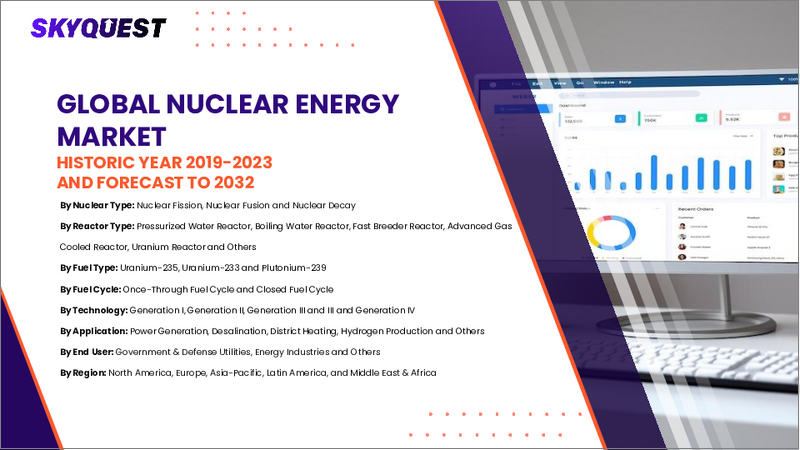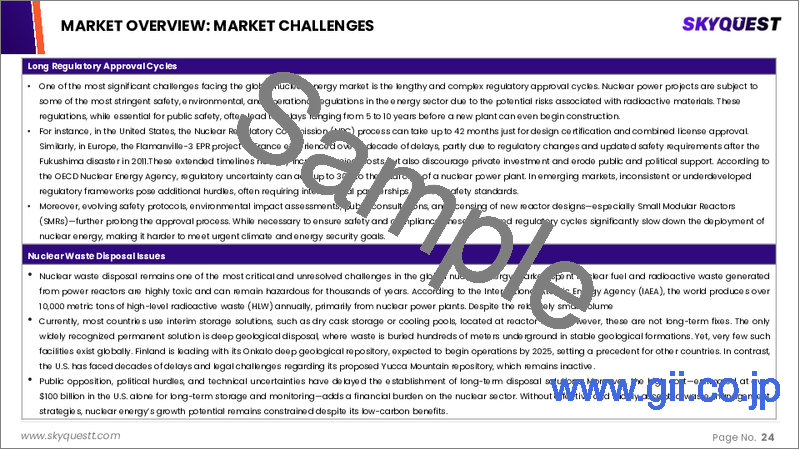|
|
市場調査レポート
商品コード
1654071
原子力エネルギーの市場規模、シェア、成長分析:タイプ別、燃料別、用途別、地域別 - 産業予測、2025年~2032年Nuclear Energy Market Size, Share, and Growth Analysis, By Type (Pressurized Water Reactor, Boiling Water Reactor), By Fuel (Uranium-235, Uranium-233), By Application, By Region - Industry Forecast 2025-2032 |
||||||
|
|||||||
| 原子力エネルギーの市場規模、シェア、成長分析:タイプ別、燃料別、用途別、地域別 - 産業予測、2025年~2032年 |
|
出版日: 2025年02月09日
発行: SkyQuest
ページ情報: 英文 157 Pages
納期: 3~5営業日
|
全表示
- 概要
- 目次
原子力エネルギーの世界市場規模は2023年に352億米ドルとなり、予測期間(2025年~2032年)のCAGRは3.1%で、2024年の362億9,000万米ドルから2032年には463億3,000万米ドルに成長する見通しです。
世界の原子力エネルギー市場は、低炭素発電を通じて気候変動を緩和しつつ、高まるエネルギー需要に対応するために不可欠です。この市場には、核燃料サプライチェーンとともに、原子力発電所の建設、運転、保守に関連する活動が含まれます。この市場の主な促進要因には、新興国における電力需要の増加と脱炭素化へのシフトが含まれ、化石燃料に代わる実行可能な選択肢として原子力への関心が再び高まっています。原子力はエネルギー安全保障と多様化のメリットをもたらす一方で、安全性への懸念、核拡散リスク、廃棄物管理などの課題も残っています。最近の動向は、安全性、効率性、市場ポテンシャルの向上を約束する小型モジューラー炉(SMR)と第四世代原子炉(GEN IV)技術の進歩を強調し、将来の原子力エネルギーの展望を形成しています。
目次
イントロダクション
- 調査の目的
- 調査範囲
- 定義
調査手法
- 情報調達
- 二次と一次データの方法
- 市場規模予測
- 市場の前提条件と制限
エグゼクティブサマリー
- 世界市場の見通し
- 供給と需要の動向分析
- セグメント別機会分析
市場力学と見通し
- 市場概要
- 市場規模
- 市場力学
- 促進要因と機会
- 抑制要因と課題
- ポーターの分析
主な市場の考察
- 主要成功要因
- 競合の程度
- 主な投資機会
- 市場エコシステム
- 市場の魅力指数(2024年)
- PESTEL分析
- マクロ経済指標
- バリューチェーン分析
- 価格分析
- 規制情勢
- ケーススタディ
- 技術の進歩
原子力エネルギーの市場規模:タイプ別 & CAGR(2025年~2032年)
- 市場概要
- 加圧水型原子炉
- 沸騰水型原子炉
- 高速増殖炉
- 先進ガス冷却炉
- ウラン原子炉
原子力エネルギーの市場規模:燃料別 & CAGR(2025年~2032年)
- 市場概要
- ウラン235
- ウラン233
- プルトニウム239
原子力エネルギーの市場規模:用途別 & CAGR(2025年~2032年)
- 市場概要
- エネルギー
- 防衛
- その他
原子力エネルギー市場規模 & CAGR(2025年~2032年)
- 北米
- 米国
- カナダ
- 欧州
- ドイツ
- スペイン
- フランス
- 英国
- イタリア
- その他欧州
- アジア太平洋
- 中国
- インド
- 日本
- 韓国
- その他アジア太平洋
- ラテンアメリカ
- ブラジル
- その他ラテンアメリカ
- 中東・アフリカ
- GCC諸国
- 南アフリカ
- その他中東・アフリカ
競合情報
- 上位5社の比較
- 主要企業の市場ポジショニング(2024年)
- 主な市場企業が採用した戦略
- 最近の市場動向
- 企業の市場シェア分析(2024年)
- 主要企業の企業プロファイル
- 企業の詳細
- 製品ポートフォリオ分析
- 企業のセグメント別シェア分析
- 収益の前年比比較(2022年~2024年)
主要企業プロファイル
- Framatome(フランス)
- NuScale Power(米国)
- Kazatomprom(カザフスタン)
- Westinghouse Electric Company(米国)
- BWX Technologies, Inc.(米国)
- GE Hitachi Nuclear Energy(米国)
- Rosatom(ロシア)
- China National Nuclear Corporation(中国)
- Korea Hydro & Nuclear Power(韓国)
- Mitsubishi Heavy Industries(日本)
- Toshiba Energy Systems & Solutions Corporation(日本)
- Doosan Heavy Industries & Construction(韓国)
- Rolls-Royce Holdings(英国)
- Bharat Heavy Electricals Limited(インド)
- Larsen & Toubro(インド)
- Atomic Energy of Canada Limited(カナダ)
- Ansaldo Nucleare(イタリア)
- Nuclear Power Corporation of India Limited(インド)
- China General Nuclear Power Group(中国)
結論と提言
Global Nuclear Energy Market size was valued at USD 35.2 billion in 2023 and is poised to grow from USD 36.29 billion in 2024 to USD 46.33 billion by 2032, growing at a CAGR of 3.1% during the forecast period (2025-2032).
The global nuclear energy market is essential for addressing rising energy demands while mitigating climate change through low-carbon electricity generation. It includes activities related to the construction, operation, and maintenance of nuclear power plants, alongside the nuclear fuel supply chain. Key drivers of this market include increasing electricity demand in emerging economies and a shift toward decarbonization, prompting renewed interest in nuclear as a viable alternative to fossil fuels. While it presents energy security and diversification benefits, challenges such as safety concerns, nuclear proliferation risks, and waste management persist. Recent trends highlight advancements in small modular reactors (SMRs) and Generation IV technologies, promising enhanced safety, efficiency, and market potential, shaping the future of the nuclear energy landscape.
Top-down and bottom-up approaches were used to estimate and validate the size of the Global Nuclear Energy market and to estimate the size of various other dependent submarkets. The research methodology used to estimate the market size includes the following details: The key players in the market were identified through secondary research, and their market shares in the respective regions were determined through primary and secondary research. This entire procedure includes the study of the annual and financial reports of the top market players and extensive interviews for key insights from industry leaders such as CEOs, VPs, directors, and marketing executives. All percentage shares split, and breakdowns were determined using secondary sources and verified through Primary sources. All possible parameters that affect the markets covered in this research study have been accounted for, viewed in extensive detail, verified through primary research, and analyzed to get the final quantitative and qualitative data.
Global Nuclear Energy Market Segments Analysis
Global Nuclear Energy Market is segmented by Type, Fuel, Application and region. Based on Type, the market is segmented into Pressurized Water Reactor, Boiling Water Reactor, Fast Breeder Reactor, Advanced Gas Cooled Reactor and Uranium Reactor. Based on Fuel, the market is segmented into Uranium-235, Uranium-233 and Plutonium-239. Based on Application, the market is segmented into Energy, Defense and Others. Based on region, the market is segmented into North America, Europe, Asia Pacific, Latin America and Middle East & Africa.
Driver of the Global Nuclear Energy Market
The Global Nuclear Energy market is significantly driven by the low carbon footprint associated with nuclear energy production, which aligns with contemporary efforts to reduce greenhouse gas emissions and combat climate change. As industries seek dependable and eco-friendly alternatives to fossil fuels, nuclear power emerges as a prime solution. Its capacity to provide a consistent energy supply while minimizing environmental impact positions it as a viable option for businesses aiming to transition towards sustainable energy sources. This shift towards nuclear energy not only supports global climate goals but also aids in meeting the increasing energy demands without compromising ecological integrity.
Restraints in the Global Nuclear Energy Market
The global nuclear energy market faces notable constraints primarily due to the substantial financial investment required for constructing nuclear power plants. The capital-intensive nature of these projects poses a significant barrier for both public and private sectors, as the initial costs can be prohibitively high. This financial burden can deter potential investors and stakeholders, limiting the growth potential of the market. Additionally, the lengthy time frames associated with the development and regulatory processes further complicate matters, making it challenging to attract funding and support. Consequently, these factors collectively contribute to the constraints impacting the advancement of the global nuclear energy sector.
Market Trends of the Global Nuclear Energy Market
The Global Nuclear Energy market is witnessing a notable trend driven by an increasing interest in carbon-free energy solutions amidst heightened climate concerns. As countries strive to meet stringent emission targets and transition to sustainable energy systems, nuclear power emerges as a viable alternative, capable of delivering substantial, consistent electricity generation without greenhouse gas emissions. This resurgence is amplified by advancements in reactor technologies, including small modular reactors (SMRs), enhancing safety and efficiency. Governments and private entities are actively investing in nuclear infrastructure, positioning the sector as a crucial player in the global energy landscape, ultimately contributing to a more sustainable and energy-secure future.
Table of Contents
Introduction
- Objectives of the Study
- Scope of the Report
- Definitions
Research Methodology
- Information Procurement
- Secondary & Primary Data Methods
- Market Size Estimation
- Market Assumptions & Limitations
Executive Summary
- Global Market Outlook
- Supply & Demand Trend Analysis
- Segmental Opportunity Analysis
Market Dynamics & Outlook
- Market Overview
- Market Size
- Market Dynamics
- Drivers & Opportunities
- Restraints & Challenges
- Porters Analysis
- Competitive rivalry
- Threat of substitute
- Bargaining power of buyers
- Threat of new entrants
- Bargaining power of suppliers
Key Market Insights
- Key Success Factors
- Degree of Competition
- Top Investment Pockets
- Market Ecosystem
- Market Attractiveness Index, 2024
- PESTEL Analysis
- Macro-Economic Indicators
- Value Chain Analysis
- Pricing Analysis
- Regulatory Landscape
- Case Studies
- Technological Advancement
Global Nuclear Energy Market Size by Type & CAGR (2025-2032)
- Market Overview
- Pressurized Water Reactor
- Boiling Water Reactor
- Fast Breeder Reactor
- Advanced Gas Cooled Reactor
- Uranium Reactor
Global Nuclear Energy Market Size by Fuel & CAGR (2025-2032)
- Market Overview
- Uranium-235
- Uranium-233
- Plutonium-239
Global Nuclear Energy Market Size by Application & CAGR (2025-2032)
- Market Overview
- Energy
- Defense
- Others
Global Nuclear Energy Market Size & CAGR (2025-2032)
- North America (Type, Fuel, Application)
- US
- Canada
- Europe (Type, Fuel, Application)
- Germany
- Spain
- France
- UK
- Italy
- Rest of Europe
- Asia Pacific (Type, Fuel, Application)
- China
- India
- Japan
- South Korea
- Rest of Asia-Pacific
- Latin America (Type, Fuel, Application)
- Brazil
- Rest of Latin America
- Middle East & Africa (Type, Fuel, Application)
- GCC Countries
- South Africa
- Rest of Middle East & Africa
Competitive Intelligence
- Top 5 Player Comparison
- Market Positioning of Key Players, 2024
- Strategies Adopted by Key Market Players
- Recent Developments in the Market
- Company Market Share Analysis, 2024
- Company Profiles of All Key Players
- Company Details
- Product Portfolio Analysis
- Company's Segmental Share Analysis
- Revenue Y-O-Y Comparison (2022-2024)
Key Company Profiles
- Framatome (France)
- Company Overview
- Business Segment Overview
- Financial Updates
- Key Developments
- NuScale Power (United States)
- Company Overview
- Business Segment Overview
- Financial Updates
- Key Developments
- Kazatomprom (Kazakhstan)
- Company Overview
- Business Segment Overview
- Financial Updates
- Key Developments
- Westinghouse Electric Company (United States)
- Company Overview
- Business Segment Overview
- Financial Updates
- Key Developments
- BWX Technologies, Inc. (United States)
- Company Overview
- Business Segment Overview
- Financial Updates
- Key Developments
- GE Hitachi Nuclear Energy (United States)
- Company Overview
- Business Segment Overview
- Financial Updates
- Key Developments
- Rosatom (Russia)
- Company Overview
- Business Segment Overview
- Financial Updates
- Key Developments
- China National Nuclear Corporation (China)
- Company Overview
- Business Segment Overview
- Financial Updates
- Key Developments
- Korea Hydro & Nuclear Power (South Korea)
- Company Overview
- Business Segment Overview
- Financial Updates
- Key Developments
- Mitsubishi Heavy Industries (Japan)
- Company Overview
- Business Segment Overview
- Financial Updates
- Key Developments
- Toshiba Energy Systems & Solutions Corporation (Japan)
- Company Overview
- Business Segment Overview
- Financial Updates
- Key Developments
- Doosan Heavy Industries & Construction (South Korea)
- Company Overview
- Business Segment Overview
- Financial Updates
- Key Developments
- Rolls-Royce Holdings (United Kingdom)
- Company Overview
- Business Segment Overview
- Financial Updates
- Key Developments
- Bharat Heavy Electricals Limited (India)
- Company Overview
- Business Segment Overview
- Financial Updates
- Key Developments
- Larsen & Toubro (India)
- Company Overview
- Business Segment Overview
- Financial Updates
- Key Developments
- Atomic Energy of Canada Limited (Canada)
- Company Overview
- Business Segment Overview
- Financial Updates
- Key Developments
- Ansaldo Nucleare (Italy)
- Company Overview
- Business Segment Overview
- Financial Updates
- Key Developments
- Nuclear Power Corporation of India Limited (India)
- Company Overview
- Business Segment Overview
- Financial Updates
- Key Developments
- China General Nuclear Power Group (China)
- Company Overview
- Business Segment Overview
- Financial Updates
- Key Developments





